
Illustrative Math Alignment: Grade 8 Unit 7
Exponents and Scientific Notation
Lesson 2: Multiplying Powers of Ten
Use the following Media4Math resources with this Illustrative Math lesson.
| Thumbnail Image | Title | Body | Curriculum Topic |
|---|---|---|---|

|
Math Clip Art--Equations and Inequalities--Equation Models--Balance Scale 2 | Math Clip Art--Equations and Inequalities--Equation Models--Balance Scale 2
This is part of a collection of math clip art images about equations and inequalities. |
Applications of Equations and Inequalities |

|
Math Clip Art--Equations and Inequalities--Equation Models--Balance Scale 3 | Math Clip Art--Equations and Inequalities--Equation Models--Balance Scale 3
This is part of a collection of math clip art images about equations and inequalities. |
Applications of Equations and Inequalities |

|
Math Clip Art--Equations and Inequalities--Equation Models--Balanced Equation | Math Clip Art--Equations and Inequalities--Equation Models--Balanced Equation
This is part of a collection of math clip art images about equations and inequalities. |
Applications of Equations and Inequalities |

|
Math Clip Art--Equations and Inequalities--Equation Models--Balanced Equation 1 | Math Clip Art--Equations and Inequalities--Equation Models--Balanced Equation 1
This is part of a collection of math clip art images about equations and inequalities. |
Applications of Equations and Inequalities |

|
Math Clip Art--Equations and Inequalities--Equation Models--Balanced Equation 2 | Math Clip Art--Equations and Inequalities--Equation Models--Balanced Equation 2
This is part of a collection of math clip art images about equations and inequalities. |
Applications of Equations and Inequalities |

|
Math Clip Art--Equations and Inequalities--Equation Models--Balanced Equation 3 | Math Clip Art--Equations and Inequalities--Equation Models--Balanced Equation 3
This is part of a collection of math clip art images about equations and inequalities. |
Applications of Equations and Inequalities |

|
Math Clip Art--Equations and Inequalities--Equation Models--Unbalanced Equation 1 Left | Math Clip Art--Equations and Inequalities--Equation Models--Unbalanced Equation 1 Left
This is part of a collection of math clip art images about equations and inequalities. |
Applications of Equations and Inequalities |

|
Math Clip Art--Equations and Inequalities--Equation Models--Unbalanced Equation 1 Right | Math Clip Art--Equations and Inequalities--Equation Models--Unbalanced Equation 1 Right
This is part of a collection of math clip art images about equations and inequalities. |
Applications of Equations and Inequalities |

|
Math Clip Art--Equations and Inequalities--Equation Models--Unbalanced Equation 2 Left | Math Clip Art--Equations and Inequalities--Equation Models--Unbalanced Equation 2 Left
This is part of a collection of math clip art images about equations and inequalities. |
Applications of Equations and Inequalities |

|
Math Clip Art--Equations and Inequalities--Equation Models--Unbalanced Equation 2 Right | Math Clip Art--Equations and Inequalities--Equation Models--Unbalanced Equation 2 Right
This is part of a collection of math clip art images about equations and inequalities. |
Applications of Equations and Inequalities |

|
Math Clip Art--Equations and Inequalities--Equation Models--Unbalanced Equation 3 Left | Math Clip Art--Equations and Inequalities--Equation Models--Unbalanced Equation 3 Left
This is part of a collection of math clip art images about equations and inequalities. |
Applications of Equations and Inequalities |

|
Math Clip Art--Equations and Inequalities--Equation Models--Unbalanced Equation 3 Right | Math Clip Art--Equations and Inequalities--Equation Models--Unbalanced Equation 3 Right
This is part of a collection of math clip art images about equations and inequalities. |
Applications of Equations and Inequalities |

|
Math Clip Art--Equations and Inequalities--Equation Models--Unbalanced Equation Left | Math Clip Art--Equations and Inequalities--Equation Models--Unbalanced Equation Left
This is part of a collection of math clip art images about equations and inequalities. |
Applications of Equations and Inequalities |

|
Math Clip Art--Equations and Inequalities--Equation Models--Unbalanced Equation Right | Math Clip Art--Equations and Inequalities--Equation Models--Unbalanced Equation Right
This is part of a collection of math clip art images about equations and inequalities. |
Applications of Equations and Inequalities |
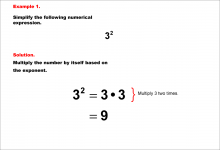
|
Math Example--Exponential Concepts--Integer and Rational Exponents--Example 1 | Math Example--Exponential Concepts--Integer and Rational Exponents--Example 1TopicExponents DescriptionShows Example 1 with the expression 32. The solution explains how to simplify by multiplying 3 by itself according to the exponent. Example 1: Simplify 32. Multiply 3 by itself two times: 3•3 = 9. |
Numerical Expressions |
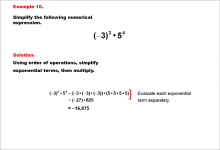
|
Math Example--Exponential Concepts--Integer and Rational Exponents--Example 10 | Math Example--Exponential Concepts--Integer and Rational Exponents--Example 10TopicExponents DescriptionShows Example 10 with the expression (-3)3•54. The solution uses order of operations to evaluate each term before multiplying. Example 10: Simplify (-3)3•54. Evaluate each exponential term separately, then multiply: -27•625= -16,875. |
Numerical Expressions |
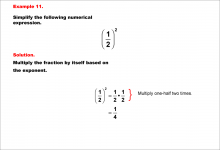
|
Math Example--Exponential Concepts--Integer and Rational Exponents--Example 11 | Math Example--Exponential Concepts--Integer and Rational Exponents--Example 11TopicExponents DescriptionExample 11 shows how to simplify (1/2)2. The image illustrates multiplying 1/2 by itself due to the exponent of 2. Example 11: Simplify (1/2)2. Multiply one-half two times. Solution: (1/2) * (1/2) = 1/4. |
Numerical Expressions |
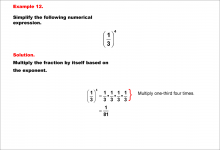
|
Math Example--Exponential Concepts--Integer and Rational Exponents--Example 12 | Math Example--Exponential Concepts--Integer and Rational Exponents--Example 12TopicExponents DescriptionExample 12 shows how to simplify (1/3)4. The image illustrates multiplying 1/3 four times due to the exponent of 4. Example 12: Simplify (1/3)4. Multiply one-third four times. Solution: (1/3) * (1/3) * (1/3) * (1/3) = 1/81. |
Numerical Expressions |
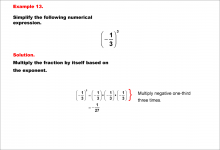
|
Math Example--Exponential Concepts--Integer and Rational Exponents--Example 13 | Math Example--Exponential Concepts--Integer and Rational Exponents--Example 13TopicExponents DescriptionExample 13 shows how to simplify (-1/3)3. The image illustrates multiplying -1/3 three times due to the exponent of 3. Example 13: Simplify (-1/3)3. Multiply negative one-third three times. Solution: (-1/3) * (-1/3) * (-1/3) = -1/27. |
Numerical Expressions |

|
Math Example--Exponential Concepts--Integer and Rational Exponents--Example 14 | Math Example--Exponential Concepts--Integer and Rational Exponents--Example 14TopicExponents DescriptionExample 14 shows how to simplify 2-1. The image illustrates rewriting 2-1 as the reciprocal of 2 raised to the first power. Example 14: Simplify 2-1. Negative exponents are written as reciprocals. Solution: 2-1 = 1/2. |
Numerical Expressions |
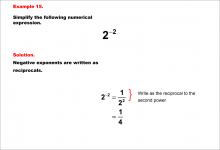
|
Math Example--Exponential Concepts--Integer and Rational Exponents--Example 15 | Math Example--Exponential Concepts--Integer and Rational Exponents--Example 15TopicExponents DescriptionExample 15 shows how to simplify 2-2. The image illustrates rewriting 2-2 as the reciprocal of 2 raised to the second power. Example 15: Simplify 2-2. Negative exponents are written as reciprocals. Solution: 2-2 = 1/(22) = 1/4. |
Numerical Expressions |
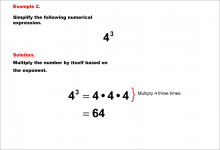
|
Math Example--Exponential Concepts--Integer and Rational Exponents--Example 2 | Math Example--Exponential Concepts--Integer and Rational Exponents--Example 2TopicExponents DescriptionShows Example 2 with the expression 43. The solution explains the simplification by multiplying 4 three times. Example 2: Simplify 43. Multiply 4 by itself three times: 4•4•4 = 64. In general, the topic of exponents involves understanding how repeated multiplication can be expressed more compactly. The examples provided in this collection allow students to see the step-by-step breakdown of how to simplify various exponential expressions, which can include positive and negative bases, fractional bases, and negative exponents. |
Numerical Expressions |
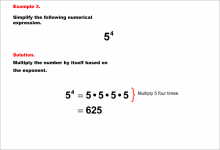
|
Math Example--Exponential Concepts--Integer and Rational Exponents--Example 3 | Math Example--Exponential Concepts--Integer and Rational Exponents--Example 3TopicExponents DescriptionShows Example 3 with the expression 54. The solution details multiplying 5 four times. Example 3: Simplify 54. Multiply 5 by itself four times: 5•5•5•5 = 625. In general, the topic of exponents involves understanding how repeated multiplication can be expressed more compactly. The examples provided in this collection allow students to see the step-by-step breakdown of how to simplify various exponential expressions, which can include positive and negative bases, fractional bases, and negative exponents. |
Numerical Expressions |
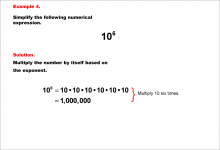
|
Math Example--Exponential Concepts--Integer and Rational Exponents--Example 4 | Math Example--Exponential Concepts--Integer and Rational Exponents--Example 4TopicExponents DescriptionShows Example 4 with the expression 106. The solution simplifies by multiplying 10 six times. Example 4: Simplify 106. Multiply 10 by itself six times: 10•10•10•10•10•10 = 1,000,000. |
Numerical Expressions |
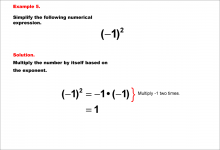
|
Math Example--Exponential Concepts--Integer and Rational Exponents--Example 5 | Math Example--Exponential Concepts--Integer and Rational Exponents--Example 5TopicExponents DescriptionShows Example 5 with the expression (-1)2. The solution explains the result by multiplying -1 by itself. Example 5: Simplify (-1)2. Multiply -1 by itself two times: (-1)•(-1) = 1. |
Numerical Expressions |
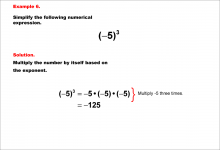
|
Math Example--Exponential Concepts--Integer and Rational Exponents--Example 6 | Math Example--Exponential Concepts--Integer and Rational Exponents--Example 6TopicExponents DescriptionShows Example 6 with the expression (-5)3. The solution demonstrates multiplying -5 three times. Example 6: Simplify (_5)3. Multiply -5 by itself three times: (-5)•(-5)•(-5) = -125. |
Numerical Expressions |

|
Math Example--Exponential Concepts--Integer and Rational Exponents--Example 7 | Math Example--Exponential Concepts--Integer and Rational Exponents--Example 7TopicExponents DescriptionShows Example 7 with the expression (-6)4. The solution explains multiplying -6 by itself four times. Example 7: Simplify (-6)4. Multiply -6 by itself four times: (-6)•(-6)•(-6)•(-6) = 1296. |
Numerical Expressions |
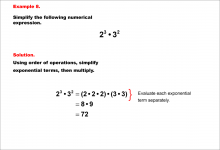
|
Math Example--Exponential Concepts--Integer and Rational Exponents--Example 8 | Math Example--Exponential Concepts--Integer and Rational Exponents--Example 8TopicExponents DescriptionShows Example 8 with the expression 23•32. The solution demonstrates using order of operations to simplify each term separately, then multiply. Example 8: Simplify 23•32. Evaluate each exponential term separately, then multiply: 8•9 = 72. |
Numerical Expressions |
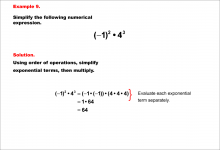
|
Math Example--Exponential Concepts--Integer and Rational Exponents--Example 9 | Math Example--Exponential Concepts--Integer and Rational Exponents--Example 9TopicExponents DescriptionShows Example 9 with the expression (-1)2•43. The solution explains simplifying each term individually before multiplying. Example 9: Simplify (-1)2•43. Evaluate each exponential term separately, then multiply: 1•64 = 64. |
Numerical Expressions |
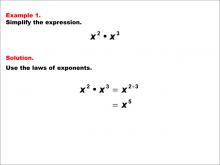
|
Math Example--Exponential Concepts--Laws of Exponents: Example 1 | Math Example--Exponential Concepts--Laws of Exponents: Example 1TopicExponents DescriptionThis example demonstrates the simplification of an expression using the laws of exponents. The problem involves simplifying x2 * x3, which results in x5 by applying the law of exponents for multiplication. This step-by-step solution helps students understand how to combine like terms with exponents. |
Laws of Exponents |
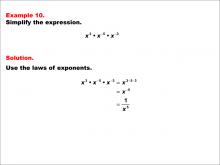
|
Math Example--Exponential Concepts--Laws of Exponents: Example 10 | Math Example--Exponential Concepts--Laws of Exponents: Example 10TopicExponents DescriptionThis example focuses on simplifying an expression with both positive and negative exponents. The problem involves simplifying x3 * x(-5) * x(-3), which results in x(-5) or 1/x5. This demonstrates how positive and negative exponents interact when multiplying terms with the same base, and how the result can be expressed as a fraction. |
Laws of Exponents |
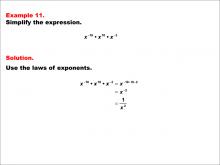
|
Math Example--Exponential Concepts--Laws of Exponents: Example 11 | Math Example--Exponential Concepts--Laws of Exponents: Example 11TopicExponents DescriptionThis example demonstrates the simplification of an expression with both positive and negative exponents, including a zero exponent. The problem involves simplifying x(-10) * x10 * x(-2), which results in x(-2) or 1/x2. This showcases how positive and negative exponents interact when multiplying terms with the same base, and how zero exponents affect the result. |
Laws of Exponents |
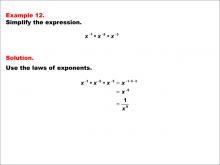
|
Math Example--Exponential Concepts--Laws of Exponents: Example 12 | Math Example--Exponential Concepts--Laws of Exponents: Example 12TopicExponents DescriptionThis example focuses on simplifying an expression with multiple negative exponents. The problem involves simplifying x(-1) * x(-5) * x(-3), which results in x(-9) or 1/x9. This demonstrates how negative exponents interact when multiplying terms with the same base, and how the result can be expressed as a fraction with a positive exponent in the denominator. |
Laws of Exponents |
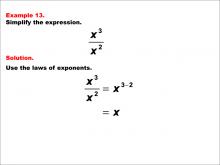
|
Math Example--Exponential Concepts--Laws of Exponents: Example 13 | Math Example--Exponential Concepts--Laws of Exponents: Example 13TopicExponents DescriptionThis example demonstrates the simplification of an expression involving division with exponents. The problem involves simplifying x3 / x2, which results in x. This showcases how exponents behave when dividing terms with the same base, illustrating the subtraction of exponents in division. |
Laws of Exponents |
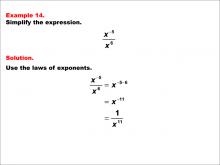
|
Math Example--Exponential Concepts--Laws of Exponents: Example 14 | Math Example--Exponential Concepts--Laws of Exponents: Example 14TopicExponents DescriptionThis example demonstrates the simplification of an expression involving division with negative exponents. The problem involves simplifying x(-5) / x6, which results in x(-11) or 1/x11. This showcases how negative and positive exponents interact when dividing terms with the same base, and how the result can be expressed as a fraction. |
Laws of Exponents |
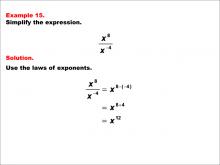
|
Math Example--Exponential Concepts--Laws of Exponents: Example 15 | Math Example--Exponential Concepts--Laws of Exponents: Example 15TopicExponents DescriptionThis example illustrates the simplification of an expression involving division with both positive and negative exponents. The problem involves simplifying x8 / x(-4), which results in x12. This demonstrates how positive and negative exponents interact when dividing terms with the same base, and how the result can yield a larger positive exponent. |
Laws of Exponents |

|
Math Example--Exponential Concepts--Laws of Exponents: Example 16 | Math Example--Exponential Concepts--Laws of Exponents: Example 16TopicExponents DescriptionThis example focuses on simplifying an expression with negative exponents in both the numerator and denominator. The problem involves simplifying x(-7) / x(-5), which results in x(-2) or 1/x2. This demonstrates how negative exponents interact when dividing terms with the same base, and how the result can be expressed as a fraction. |
Laws of Exponents |
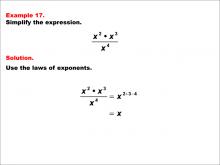
|
Math Example--Exponential Concepts--Laws of Exponents: Example 17 | Math Example--Exponential Concepts--Laws of Exponents: Example 17TopicExponents DescriptionThis example demonstrates the simplification of an expression involving multiplication and division with exponents. The problem involves simplifying (x2 * x3) / x4, which results in x. This showcases how exponents behave when multiplying and dividing terms with the same base, illustrating the addition and subtraction of exponents in a single expression. |
Laws of Exponents |
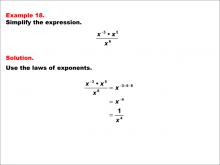
|
Math Example--Exponential Concepts--Laws of Exponents: Example 18 | Math Example--Exponential Concepts--Laws of Exponents: Example 18TopicExponents DescriptionThis example focuses on simplifying an expression involving multiplication and division with both positive and negative exponents. The problem involves simplifying (x-3 * x5) / x6, which results in x-4 or 1/x4. This demonstrates how positive and negative exponents interact when multiplying and dividing terms with the same base, and how the result can be expressed as a fraction. |
Laws of Exponents |
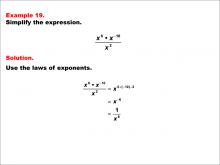
|
Math Example--Exponential Concepts--Laws of Exponents: Example 19 | Math Example--Exponential Concepts--Laws of Exponents: Example 19TopicExponents DescriptionThis example demonstrates the simplification of an expression involving multiplication and division with both positive and negative exponents. The problem involves simplifying (x6 * x-10) / x2, which results in x-6 or 1/x6. This showcases how positive and negative exponents interact when multiplying and dividing terms with the same base, and how the result can be expressed as a fraction. |
Laws of Exponents |

|
Math Example--Exponential Concepts--Laws of Exponents: Example 2 | Math Example--Exponential Concepts--Laws of Exponents: Example 2TopicExponents DescriptionThis example focuses on simplifying an expression with negative exponents using exponent rules. The problem involves simplifying x(-3) * x4, which results in x1 or simply x. This demonstrates how positive and negative exponents interact when multiplying terms with the same base. |
Laws of Exponents |
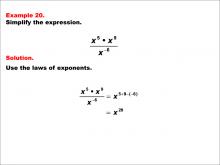
|
Math Example--Exponential Concepts--Laws of Exponents: Example 20 | Math Example--Exponential Concepts--Laws of Exponents: Example 20TopicExponents DescriptionThis example demonstrates the simplification of an expression involving multiplication and division with both positive and negative exponents. The problem involves simplifying (x5 * x9) / x-6, which results in x20. This showcases how positive and negative exponents interact when multiplying and dividing terms with the same base, and how dividing by a negative exponent can lead to a larger positive exponent. |
Laws of Exponents |
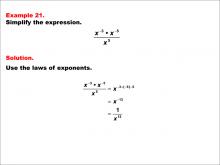
|
Math Example--Exponential Concepts--Laws of Exponents: Example 21 | Math Example--Exponential Concepts--Laws of Exponents: Example 21TopicExponents DescriptionThis example focuses on simplifying an expression involving multiplication and division with negative exponents. The problem involves simplifying (x(-3) * x(-5)) / x5, which results in 1/x13. This demonstrates how negative exponents interact when multiplying and dividing terms with the same base, and how the result can be expressed as a fraction with a positive exponent in the denominator. |
Laws of Exponents |
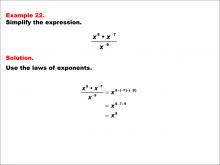
|
Math Example--Exponential Concepts--Laws of Exponents: Example 22 | Math Example--Exponential Concepts--Laws of Exponents: Example 22TopicExponents DescriptionThis example demonstrates the simplification of an expression involving multiplication and division with both positive and negative exponents. The problem involves simplifying (x6 * x(-7)) / x(-9), which results in x8. This showcases how positive and negative exponents interact when multiplying and dividing terms with the same base, and how dividing by a negative exponent can lead to a positive result. |
Laws of Exponents |
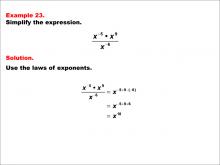
|
Math Example--Exponential Concepts--Laws of Exponents: Example 23 | Math Example--Exponential Concepts--Laws of Exponents: Example 23TopicExponents DescriptionThis example focuses on simplifying an expression involving multiplication and division with both positive and negative exponents. The problem involves simplifying (x(-5) * x9) / x(-6), which results in x10. This demonstrates how positive and negative exponents interact when multiplying and dividing terms with the same base, and how dividing by a negative exponent can lead to a larger positive exponent. |
Laws of Exponents |
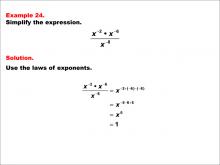
|
Math Example--Exponential Concepts--Laws of Exponents: Example 24 | Math Example--Exponential Concepts--Laws of Exponents: Example 24TopicExponents DescriptionThis example demonstrates the simplification of an expression involving multiplication and division with negative exponents. The problem involves simplifying (x(-2) * x(-6)) / x(-8), which results in 1. This showcases how negative exponents interact when multiplying and dividing terms with the same base, and how they can cancel out to yield a result of 1. |
Laws of Exponents |
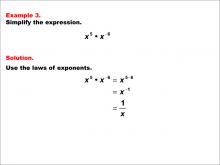
|
Math Example--Exponential Concepts--Laws of Exponents: Example 3 | Math Example--Exponential Concepts--Laws of Exponents: Example 3TopicExponents DescriptionThis example demonstrates the simplification of an expression resulting in a negative exponent. The problem involves simplifying x5 * x(-6), which results in x(-1) or 1/x. This showcases how positive and negative exponents interact and how the result can be expressed as a fraction. |
Laws of Exponents |

|
Math Example--Exponential Concepts--Laws of Exponents: Example 4 | Math Example--Exponential Concepts--Laws of Exponents: Example 4TopicExponents DescriptionThis example focuses on simplifying an expression with two negative exponents, resulting in a fraction. The problem involves simplifying x(-10) * x(-7), which results in x(-17) or 1/x17. This demonstrates how negative exponents combine and how the result can be expressed as a fraction with a positive exponent. |
Laws of Exponents |
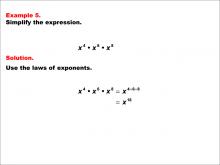
|
Math Example--Exponential Concepts--Laws of Exponents: Example 5 | Math Example--Exponential Concepts--Laws of Exponents: Example 5TopicExponents DescriptionThis example demonstrates the simplification of an expression using exponents with multiple terms. The problem involves simplifying x4 * x6 * x8, which results in x18. This showcases how the exponents of terms with the same base can be added when multiplying. |
Laws of Exponents |
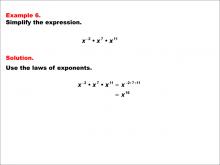
|
Math Example--Exponential Concepts--Laws of Exponents: Example 6 | Math Example--Exponential Concepts--Laws of Exponents: Example 6TopicExponents DescriptionThis example focuses on simplifying an expression with both negative and positive exponents. The problem involves simplifying x(-2) * x7 * x11, which results in x16. This demonstrates how positive and negative exponents interact when multiplying terms with the same base, and how they can be combined to yield a single positive exponent. |
Laws of Exponents |